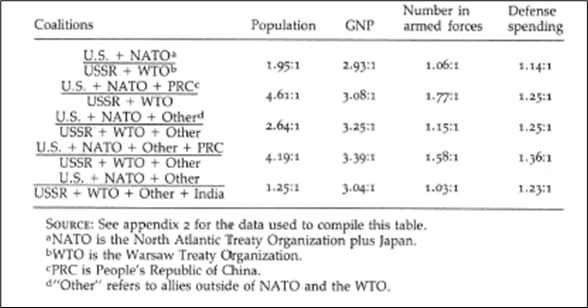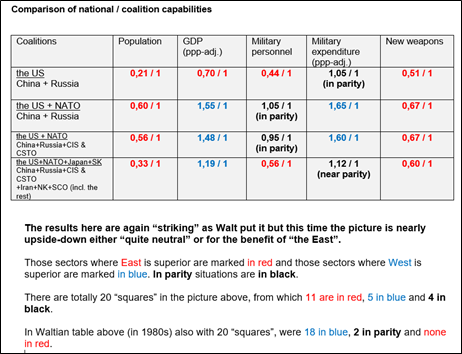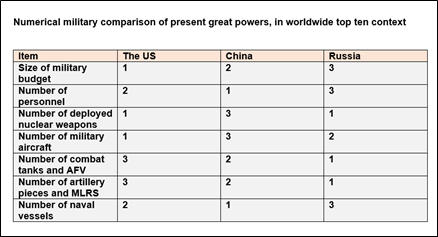Military-political positioning
Key features of recent military-political positioning are moving to confrontational direction in the triangle game of great powers
In the Stephen Walt’s capability formulas, dated in late 1980s, the distribution of capabilities between the two alliances is shown in table below. The results were striking, indicating the coming collapse and disintegration of USSR and Warsaw Treaty Organization.

Measuring the effective power of states or coalitions can be complicated and mathematically or statistically challenging. Fortunately, a detailed profound net assessment is not necessary here.
A rough but reliable uptodate comparison of the Russian, Chinese and US coalition systems can be obtained by considering the following main items: population, GDP, size of armed forces, defense expenditures as well as inventions of cutting-edge new weapons.
All the necessary data and information can be found in key drivers of military capabilities.
When this above Waltian formula is re-calculated corresponding to the present situation 2018, the following statistical picture can be reached:

In the table below, great powers have been ranked by certain items in the worldwide scale. The result is interesting, the US is scoring 13 points and others 14 points indicating that militarily those countries are not so far from each other.

Recent Western comments about the present great power military situation can be found here (DW article).
Military-political relation between China and the US in 2019
Thucydides Trap in the context of Sino-American relations.
Graham Allison found, when analyzing the relations of the present unipole, the US, and the rising challenger power, China, that those two nations should avoid the “Thucydides Trap”.
In the History of Peloponnesian War, Thucydides wrote: ”What made war inevitable was the growth of Athenian power and the fear which this caused in Sparta”. Thus, Thucydides identified the core problem: the inevitable structural stress caused by rapid shift in the balance of power between two rivals.
To sum up, the Thucydides Trap refers to the inescapable anxiety that accompanies a sharp shift in the relative power of potential competitors. Under such circumstances, unexpected actions by third parties can provide a spark that leads to results neither competitor would have chosen. Thucydides noted also that this may lead to strengthen alliances referring to old principle of international politics where “the enemy of my enemy is my friend”. When looking at this structural dynamic creating the Thucydides Trap from the view point of the modern theory of realism, the big picture and composition are in conformity.
China’s rapid military modernization, internal document
China’s rapid military modernization is “remarkable,” and is no longer merely “catching up” with the West, reports the International Institute for Strategic Studies (IISS) in their annual report on global military capabilities. China’s emerging weapons developments and broader defense-technological progress mean that it has become a global defense innovatorand its behavior resembles increasingly “the genuine great power”.
China’s military reforms have been revealed by leaked internal documents, which indicate Beijing intends to expand its military might offshore so that the country will be allowed to “manage a crisis, contain a conflict, win a war” and overtake the United States in military strength. The leaked documents were published by the Central Military Commission in February 2018 for the purpose of spreading President Xi Jinping’s “thought on strengthening the armed forces”. When the military reforms go ahead, they will lead to heightened tensions with China’s neighbouring countries, including Japan, in the East and South China Seas and the US.
The authors of the report argue a “strong military might is important for a country to grow from being big to being strong,” indicating that the US, Russia and Japan are the example of it. The document gives particular importance to avoiding the Thucydides Trap, which is when a rising power comes into conflict with a more established enemy.
The report said a strong military is the best way to “escape the obsession that war is unavoidable between an emerging power and a ruling hegemony”. A direct confrontation with the US is referred to as “a slower vehicle on a curve”, which means it is in decline but it also claims the aim of the reforms is to surpass the American military might. In May 2018, the United States raised again concerns with China about its latest militarization of the South China Sea and claimed there will be short-term and long-term consequences.
Nuclear posture of Sino-American relations
The US is another of those countries with massive nuclear arsenal and full nuclear triad (the US and Russia). Pentagon has had quite slow pace developing its nuclear arsenal but announced in early 2020 the deployment of sea-based ballistic missiles (Trident) outfitted with low-power nuclear warheads (W76-2).
China has been a “developing country” in this nuclear respect, however “very progressing”. China invests considerable resources to maintain a limited, survivable nuclear force that can guarantee a damaging retaliatory strike. As part of this, China has long maintained a “no first use” (NFU) policy, stating it would use nuclear forces only in response to a nuclear strike against China.
China tries to optimize its nuclear force structure, improve strategic early warning, command and control, missile penetration, rapid reaction and survivability and protection as well as deter other countries from using or threatening to use nuclear weapons against China. Due to this disparity in the nuclear capabilities, the nuclear war scenario has not been so strongly connected to Sino-American relations as is the situation in Russia-the US relations.
Recent strong development in Chinese nuclear capability and capacity, in hypersonic and ASAT technology as well as in the overall military modernization has now changing the picture considerably. The US believes that China will double the size of its nuclear stockpile by the end of this decade, a Department of Defense Senior official told reporters in early 2020.
Recent statements by eminent military and political officials, China-the US
“Any irresponsible comments from other countries cannot be accepted,” Chinese Lieutenant General He Lei said at the Shangri-La Dialogue in Singapore in June 2018, after US Defense Secretary James Mattis promised to “vigorously” compete and confront Beijing’s growing influence in the disputed waters of the South China Sea. A Chinese general defended South China Sea deployments and policy, slamming “irresponsible” comments and interference in internal affairs by Mattis, who accused Beijing of intimidating its neighbors.
The US has agitated China by claiming a “freedom of navigation,” sailing its warships and conducting flights near the disputed areas of the South China Sea. To reinforce its territorial claims, Beijing has been building artificial islands and deploying military infrastructure on the Paracels, as well as on the Spratly Islands. Few days later President Xi and Mattis met and Xi repeated that “China is committed to peace but will not give up “even one inch” of territory.”
China’s military “is likely training for strikes” against US and allied targets in the Pacific, a Pentagon report (2020 China Military Power, Report to Congress) warns. China is increasing its ability to send bomber planes further afield. The warning about air strikes is one part of a comprehensive assessment of China’s military and economic ambitions. The PLA may demonstrate the “capability to strike US and allied forces and military bases in the western Pacific Ocean, including Guam,” the report adds.
In Chinese-American relations, one of the most high-profile areas is the South China Sea and another flashpoint is Taiwan, which is seen by China as a breakaway province and thus being the internal matter of China. The Pentagon report warns that China “is likely preparing for a contingency to unify Taiwan with China by force”. “Should the United States intervene, China would try to delay effective intervention and seek victory in a high-intensity, limited war of short duration,” the report says. According to the US-China war path scenarios of American think tanks (RAND, GPF, Project Syndicate etc.), there are two war scenarios. In the first, China invades Taiwan. In the second, the US decides to block the exits of the South and East China Sea, in order to cut China’s global maritime access.
The former commander of the US Army in Europe, Retired Lt. Gen. Ben Hodges, has issued an assessment of the deteriorating state of US-Chinese relations, predicting that it’s very likely the two nations will be at war in fifteen years. Speaking at the Warsaw Security Forum in October 2018, he said that the United States will have to shift its military to the Pacific “to deal with the Chinese threat” – requiring Europe to take a more active role in its own defenses. Hodges stated also that relations between US and China were becoming “increasingly tense,” accusing Beijing of stealing technology and gaining control of strategically important infrastructure across Africa and Europe. He claimed that in Europe, China owns more than 10 percent of the ports.
In late October 2018, during an inspection of the Southern Theatre Command of PLA, President Xi Jinping ordered the nation’s military group that monitors the South China Sea and Taiwan to “prepare the war,” at a time when tensions between China and the US continue to grow over trade issues and Beijing’s expansion in the Indo-Pacific. “It’s necessary to strengthen the mission and concentrate preparations for fighting a war,” Xi said.
Rear Admiral Lou Yuan, deputy head of the Chinese Academy of Military Sciences, has told (in December 2018) that the ongoing disputes over the ownership of the East and South China Seas could be resolved by sinking two US super carriers. Taiwan reported that Admiral Lou gave a wide-ranging speech on the state of Sino-US relations. According to Lou China’s new and highly capable anti-ship ballistic and cruise missiles were more than capable of hitting US carriers, despite them being at the centre of a ‘bubble’ of defensive escorts. “What the United States fears the most is taking casualties,” Admiral Lou declared. He said the loss of one super carrier would cost the US the lives of 5000 service men and women. Sinking two would double that toll. “We’ll see how frightened America is,” Admiral Lou said.
President Xi Jinping January 4, 2019, ordered the Chinese armed forces to enhance their combat readiness. Xi said the armed forces had resolutely safeguarded national sovereignty, security and development interests and withstood complex situations and severe struggles. “The world is facing a period of major changes and risks never seen in a century, and China is still in an important period of strategic opportunity for development,” he said. Regarding combat capability as the only and fundamental criterion, Xi ordered all work, forces and resources to focus on military preparedness and ensure a marked progress. The core theme of Xi’s speech was that PLA shall be ready for battle as the country faces unprecedented risks and challenges.
The Chinese modernization process and built up of military forces has shaken the hegemony that the United States enjoyed during the transition period in the wake of the Cold War has ended. The new polarity is on its way and China is beginning to play an increasingly distinct role of a superpower in it.
This fact pains Washington a great deal, especially the ongoing strengthening of the Chinese Armed Forces, which, despite the constantly increasing US military budget expenditures, are trying “not to lag behind” the development of the US Armed Forces. In its recent reports on the strategic military intentions of Beijing, the US Defense Intelligence Agency (DIA) comes to some shocking and disturbing conclusions regarding the rather rapid progress of China in the field of advanced military technologies, in particular, in the field of creating hypersonic weapons, where the US has fallen behind. These fears have been expressed by numerous American high-rank military officials during last few years.
In his speech, August 2019, President Xi Jinping has called on the air force to enhance its capability to win when inspecting an air force base in northwest China’s Gansu Province,
and greet the 70th anniversary of the founding of the People’s Republic of China (PRC) with great achievements. Xi asked for persistent efforts in improving military preparedness to ensure that the air force can fight and emerge victorious when called upon. The combat forces and support forces should be developed through military training under real combat conditions and joint operations, Xi said.
Military-political relation between Russia and the US in 2019
Nuclear posture of Russian-American relations
Number of political analysts list the sharp deterioration of military-political situation in various conflict zones as one of the factors that could trigger WWIII and an unavoidable nuclear exchange between the US and Russia, two superior nuclear weapon holders in the world with each capacity to devastate the whole humanity on the planet many thousand times. Many experts believe also that the US withdrawal from the INF treaty could heighten the nuclear standoff risks between Russia and America.
Obviously, even the sharpest deterioration in the Syrian or in any other local conflict might unlikely trigger a massive nuclear attack on Moscow or Washington. Most of the speculations cannot provide the specific course of events that could force Russia and the US into a nuclear exchange. Despite the fact that US-Russia relations have been deteriorating lately, there is difficult to find such territorial, financial, or ideological contradictions between the two countries that should bring them to a massive nuclear exchange. Hence, the overall nuclear war scenario may still be more a theoretical or technical case.
However, the recent modification in the US nuclear doctrine and practical measures to deploy the sea-based ballistic missiles (Trident) outfitted with low-power nuclear warheads (W76-2), are aimed to counter the “Russian threat”.
The measure was officially taken by the US authorities to reduce the risk of nuclear war although many critics (Bulletin of Atomic Scientists) believe this will increase rather than disease the risk of nuclear war. Russia’s nuclear posture has been so far the similar than before, stating that even the “limited, small-scale” nuclear attack against Russia or its allies means all-out nuclear war and full-range retaliatory strikes without any limits.
But due to fundamental research and development results of the last ten years, the Russian military capability and capacity have also changed dramatically Russian-American military relations and the balance of power, especially in hypersonics, ASAT technology and new air defense systems.
However, if trying to classify a hypothetical war between the US and Russia, it would most probably be a protracted nuclear world war. From the very beginning, this warfare would be characterized by a mutual unlimited use of all available mass destruction weapons, primarily strategic nuclear arsenals, which would entail a catastrophic aftermath not only for the two belligerent nations, but also for all the other countries of the world. Both the West and the East know this perfectly well.
Senior vice president of the Washington-based Center for Strategic and International Studies (CSIS) James Andrew Lewis wrote in September 2018 that with the advent of nuclear weapons, major powers have sought to avoid direct military confrontation and wars.
According to Lewis, “the US finds itself now in a world where its soft power is diminished and its hard power less useful.” Emerging powers see themselves as challenging the US for economic power, international influence and regional leadership. Some have moved from challenge to conflict. In this environment, says Lewis, Washington’s opponents will exploit the opportunities created by information technology for damaging the US and advancing their national interests. He calls it a new kind of conflict whose core is information and the cognitive effect it produces.
Obviously, the reciprocal suspicion and mistrust between Russia and the US slow down and even prohibit the most endeavours to agree on nuclear weapons (like the recent case of INF agreement). It is the unequivocal stance of Russia that “The US’ single strategic objective, in terms of Russian nuclear triad, is to strip it of its arsenal. This is what shapes all of the White House’s foreign policy while any talk about nuclear arms reduction is just cover for that.”
On the other hand, the present extreme toxic and anti-Russian attitude in the US Congress and among the both parties tell that although the nuclear war between great powers may be far-situating event, the present mental atmosphere is quite favourable even for severe confrontation between the US and Russia.
When taking into account the overall context of recent events and statements, the resulting picture seems to be less promising for the peace in the future.
- present US deployment of low yield mini nukes and Russia’s strong modernization process of its nuclear arms
- large scale US exercises of nuclear attacks on Russia and
- coming massive NATO drills in Europe 2020 as well as Russian large exercises
- the statement of commander of US European Command (SACEUR) where US Air Force General Wolters told the Senate in late February 2020 that he “is a fan of flexible first strike” regarding NATO’s nuclear weapons in Europe


